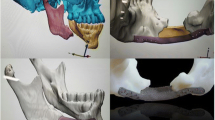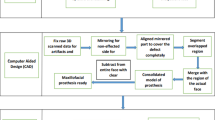Abstract
Background
This article discusses the application of computer-aided design and rapid prototyping techniques in prosthetic chin augmentation for mild microgenia.
Methods
Nine cases of mild microgenia underwent an electrobeam computer tomography scan. Then we performed three-dimensional reconstruction and operative design using computer software. According to the design, we determined the shape and size of the prostheses and made an individualized prosthesis for each chin augmentation with the rapid prototyping technique.
Results
With the application of computer-aided design and a rapid prototyping technique, we could determine the shape, size, and embedding location accurately. Prefabricating the individual prosthesis model is useful in improving the accuracy of treatment. In the nine cases of mild microgenia, three received a silicone implant, four received an ePTFE implant, and two received a Medpor implant. All patients were satisfied with the results. During follow-up at 6–12 months, all patients remained satisfied.
Conclusion
The application of computer-aided design and rapid prototyping techniques can offer surgeons the ability to design an individualized ideal prosthesis for each patient.


















Similar content being viewed by others
References
Guyuron B, Michelow BJ, Willis L (1995) Practical classification of chin deformities. Aesthet Plast Surg 19:257–264
Stambaugh KI (1992) Chin augmentation: an important adjunctive procedure to rhinoplasty. Arch Otolaryngol Head Neck Surg 118:682–686
McCarthy JG (1990) Plastic surgery. WB Saunders, Philladephia, pp 1350–1332
McCarthy JG, Ruff GL, Zide MB (1991) A surgical system for the correction of bony chin deformity. Clin Plast Surg 18:139–152
Li Y, Zhen Y (2007) Application of rapid prototyping in craniofacial surgery. Chin J Aesth Med 16(9):1309–1311
Liu XJ, Gui L, Zhang ZY, Peng X, Liu C (2006) The application of three-dimensional skull model in the treatment of craniofacial malformation. Zhonghua Zheng Xing Wai Ke Za Zhi [Chin J Plast Surg] 22(3):169–171
Author information
Authors and Affiliations
Corresponding author
Rights and permissions
About this article
Cite this article
Li, M., Lin, X. & Xu, Y. The Application of Rapid Prototyping Technique in Chin Augmentation. Aesth Plast Surg 34, 172–178 (2010). https://doi.org/10.1007/s00266-009-9397-x
Received:
Accepted:
Published:
Issue Date:
DOI: https://doi.org/10.1007/s00266-009-9397-x




